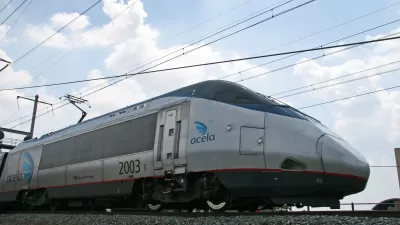This article from Next American City looks at rising ridership on Amtrak and how the train operator is not quite ready to handle it.
"Although Amtrak runs some trains on time, and with a degree of proficiency and professionalism, its deep-rooted, systemic problems continue to haunt the company: poor on-time performance, run-down equipment, unappealing stations and spotty on-board service. Veteran passengers and even train crews will share stories of broken toilets, dirty trains, diner cars without food and long delays due to freight traffic. Yet they also celebrate the comfort and romance of train travel on a good day - camaraderie among passengers, comfortable seating, pretty good food when it's available, sublime landscapes and freedom from driving."
"Despite its problems, Amtrak will carry about 28 million passengers in 2008, up from 25.8 million last year. Trains ran at 90 percent to full capacity. Ticket revenues exceeded last year's by 16 percent. It's no exaggeration then to say that Amtrak and America are on the verge of a rail renaissance, but this transformation won't happen overnight, warns Amtrak spokesman Cliff Black. 'The irony of this boom is that we are not prepared for a wholesale shift to passenger rail. The market is there, but we don't have the additional equipment and the excess capacity. We're running the wheels off some of these trains,' he admits. 'We need to make significant investments, and it's going to take some time.'"
Amtrak has run bare-bones for years, unable to purchase new passenger cars, cutting routes, and paying down debt. It owns only a small portion of track on its 22,000-mile network, so it cannot add trains and routes except by negotiating with the freight companies, who are experiencing their own boom in business."
FULL STORY: A New Era for Train Travel?

Maui's Vacation Rental Debate Turns Ugly
Verbal attacks, misinformation campaigns and fistfights plague a high-stakes debate to convert thousands of vacation rentals into long-term housing.

Planetizen Federal Action Tracker
A weekly monitor of how Trump’s orders and actions are impacting planners and planning in America.

In Urban Planning, AI Prompting Could be the New Design Thinking
Creativity has long been key to great urban design. What if we see AI as our new creative partner?

King County Supportive Housing Program Offers Hope for Unhoused Residents
The county is taking a ‘Housing First’ approach that prioritizes getting people into housing, then offering wraparound supportive services.

Researchers Use AI to Get Clearer Picture of US Housing
Analysts are using artificial intelligence to supercharge their research by allowing them to comb through data faster. Though these AI tools can be error prone, they save time and housing researchers are optimistic about the future.

Making Shared Micromobility More Inclusive
Cities and shared mobility system operators can do more to include people with disabilities in planning and operations, per a new report.
Urban Design for Planners 1: Software Tools
This six-course series explores essential urban design concepts using open source software and equips planners with the tools they need to participate fully in the urban design process.
Planning for Universal Design
Learn the tools for implementing Universal Design in planning regulations.
planning NEXT
Appalachian Highlands Housing Partners
Mpact (founded as Rail~Volution)
City of Camden Redevelopment Agency
City of Astoria
City of Portland
City of Laramie




























